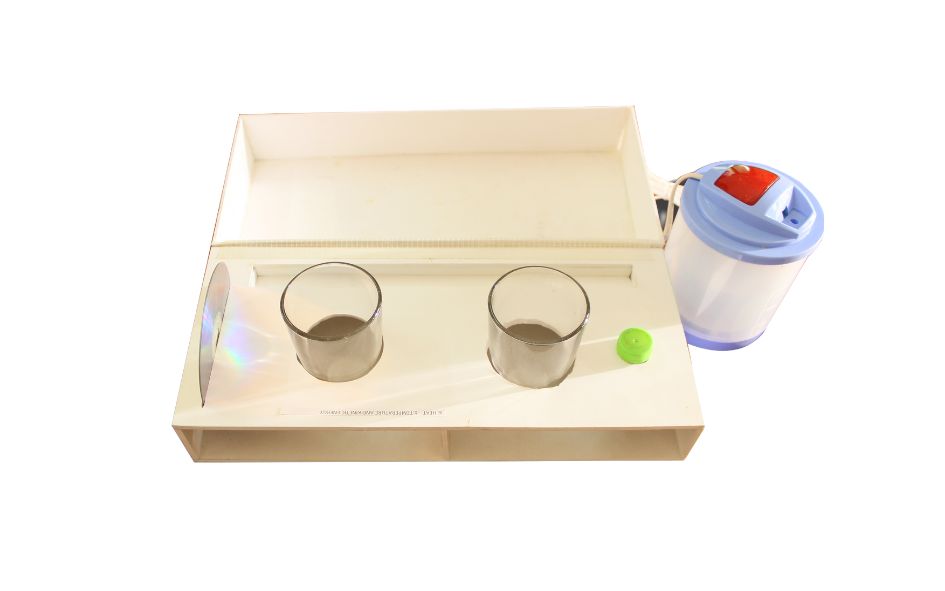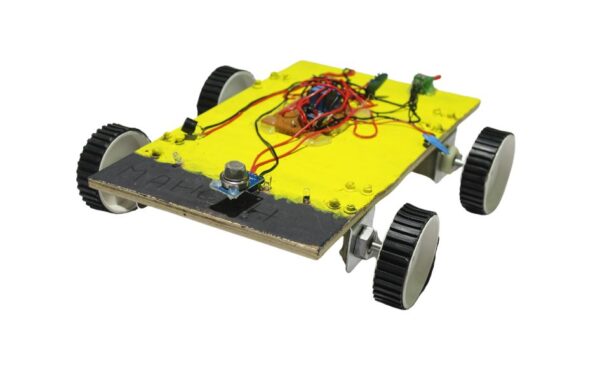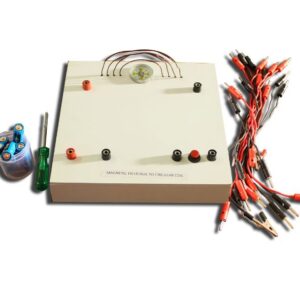Harmful Gas Detecting Robot working model
ROBOTIC LAB EQUIPMENT WORKING MODEL / ROBOTIC EXHIBITION WORKING MODEL / ROBOTIC WORKING MODEL
3 in stock
Refund
Unfortunately, once an order is placed, there is no refund available. However, we do offer exchanges for defective or damaged items.
Due to the nature of our products and the potential for misuse or mishandling, we do not offer refunds. We believe in customer satisfaction and strive to provide quality exchanges for any issues that may arise.
If you have received a defective or damaged item, please contact our customer service team and they will assist you with the exchange process. Please note that exchanges are subject to availability and product conditions.
We do not offer refunds for change of mind purchases, but we do offer exchanges for valid reasons such as defects or damages.
Delivery
My Science Kart delivers orders through a reliable and efficient shipping service to ensure your products arrive safely and on time.
Yes, you can easily track your order from My Science Kart by using the tracking number provided to you once your order has been shipped.
If you have any issues with your order from My Science Kart, please contact our customer service team who will be happy to assist you and resolve any problems.
Payment
You can pay for your purchases on My Science Kart using various payment methods such as credit/debit cards, net banking, UPI’s and mobile wallets.
Yes, we use industry-standard encryption technology to protect your payment information and ensure that it is secure.
If you have any payment-related queries or issues on My Science Kart, you can contact our customer support team through the website or email us at support@mysciencekart.com.
Harmful Gas Detecting Robot working model
Creating a harmful gas detecting robot working model is an excellent educational project for students, combining elements of robotics, electronics, programming, and environmental science. Below is a step-by-step guide to building a basic harmful gas detecting robot model:
**Materials Needed:**
1. Chassis (can be made from plastic, wood, or metal)
2. Motors and motor drivers
3. Wheels or tracks for mobility
4. Gas sensors (such as MQ series sensors for detecting specific gases like CO, CO2, LPG, etc.)
5. Microcontroller (Arduino or Raspberry Pi)
6. Battery pack
7. Display module (LCD or OLED)
8. Buzzer or alarm module
9. Enclosure for housing electronics
10. Glue, tape, screws, and basic tools
**Steps:**
**1. Design the Chassis:**
– Sketch out the design for the robot’s chassis, considering factors like stability, weight distribution, and space for components.
– Choose materials for the chassis that are sturdy and lightweight, suitable for carrying the robot’s components.
**2. Install the Motors and Mobility System:**
– Attach motors to the chassis and mount wheels or tracks for mobility.
– Connect the motors to motor drivers and wire them to the microcontroller for control.
**3. Integrate Gas Sensors:**
– Install gas sensors onto the chassis, ensuring that they are positioned to detect harmful gases in the environment.
– Wire the gas sensors to the microcontroller for data acquisition and processing.
**4. Design the Display and Alarm System:**
– Connect a display module (LCD or OLED) to the microcontroller to show real-time gas concentration readings.
– Install a buzzer or alarm module to provide audible alerts when harmful gas levels exceed predefined thresholds.
**5. Wire and Connect Electronics:**
– Connect all electronic components, including motors, gas sensors, display module, and alarm module, to the microcontroller.
– Use jumper wires and connectors to make secure connections and avoid loose connections.
**6. Program the Microcontroller:**
– Write code to read data from the gas sensors, process the information, and display gas concentration readings on the display module.
– Implement algorithms to trigger the alarm module when gas levels exceed safe limits.
– Use Arduino IDE or Python for Raspberry Pi to program the microcontroller.
**7. Test and Calibration:**
– Test the robot in a controlled environment with known gas concentrations to calibrate the gas sensors.
– Fine-tune the sensor readings and alarm thresholds as needed to ensure accurate detection and timely alerts.
**8. Demonstration and Presentation:**
– Showcase the harmful gas detecting robot to students, teachers, or parents, demonstrating its functionality and effectiveness.
– Explain the importance of monitoring air quality and the role of robots in environmental monitoring and safety.
– Discuss potential applications of the robot in detecting harmful gases in indoor and outdoor environments.
Building a harmful gas detecting robot working model provides students with hands-on experience in robotics, electronics, programming, and environmental science, fostering critical thinking, problem-solving skills, and STEM literacy. It offers an engaging educational opportunity to learn about air quality monitoring and the use of technology for environmental protection and public health.
Advanced Safety Technology
Guard Against Gas Hazards Ensure the highest level of safety in industrial and residential settings with the Harmful Gas Detecting Robot Working Model. This essential safety tool is designed to autonomously patrol areas and detect the presence of harmful gases, such as carbon monoxide, methane, and hydrogen sulfide. By providing early warnings, it helps prevent gas-related accidents and ensures a safer environment for everyone.
Robotic Precision and Reliability
Innovative Detection for a Safer Tomorrow The Harmful Gas Detecting Robot features advanced sensors that pinpoint gas accumulations even at low concentrations, which might go undetected by traditional methods. Its rapid response capabilities and robust navigation system allow it to reach and monitor various environments, from tight industrial spaces to open residential areas, providing real-time alerts and data to keep people safe.
Why Choose Our Gas Detection Robot?
Proactive Protection in Hazardous Environments Choosing the Harmful Gas Detecting Robot means investing in peace of mind. This robot is not only a preventive measure against potential gas leaks but also a critical component in emergency response strategies. It’s equipped with communication technologies that instantly relay information to control centers, facilitating quick evacuations and interventions when necessary.
| Weight | 1 kg |
|---|---|
| Dimensions | 25 × 25 × 6 cm |
You must be logged in to post a review.
Q & A
Related Products
RIGHT HAND RULE - 2 WORKING MODEL
- ✓ 100% Quality products
KIRCHHOFF'S JUNCTION LAW WORKING MODEL
- ✓ 100% Quality products
ELECTRIC SHOCK WORKING MODEL
- ✓ 100% Quality products
OHM'S LAW WORKING MODEL
- ✓ 100% Quality products
LIGHT RAY TRAVELS FROM A DENSER MEDIUM TO RARER MEDIUM WORKING MODEL
- ✓ 100% Quality products
MAGNETIC FIELD DUE TO CIRCULAR COIL WORKING MODEL
- ✓ 100% Quality products
REFRACTIVE INDEX OF THE PRISAM WORKING MODEL
- ✓ 100% Quality products
KIRCHHOFF'S LOOP LAW WORKING MODEL
- ✓ 100% Quality products
Product categories
- Circuits & Projects 220
- My Science Kart 652
- Raw Materials For Projects & Lab Equipments 368
- Science Exhibition 503
- Science Exhibition Projects & Working Models 330
- Biology Science Exhibition Projects & Working Models 30
- Chemistry Science Exhibition Projects & Working Models 12
- Mathematics Science Exhibition projects & Working Models 7
- Physics Science Exhibition Projects & Working Models 129
- Robotics Science Exhibition Projects & Working Models 10
- Social Science Exhibition Projects & Working Models 20
- Science Lab Equipments With Working Models 351
Cart
TRULY INDIAN EDUCATION BRAND
Over 10,000+ Happy Customers
My Science Kart
Address:- Ground floor, Lakshmi Nagar, D.No:- 40-1/1-5, PVP Mall Backside, Mogalrajapuram, Labbipet, Vijayawada, Andhra Pradesh 520010
7673977997, 0866-3543677
mysciencekart@gmail.com
Categories
MAP
© My Science Kart 2024, Designed & Developed By Synfocy Tech Solutions












Reviews
There are no reviews yet